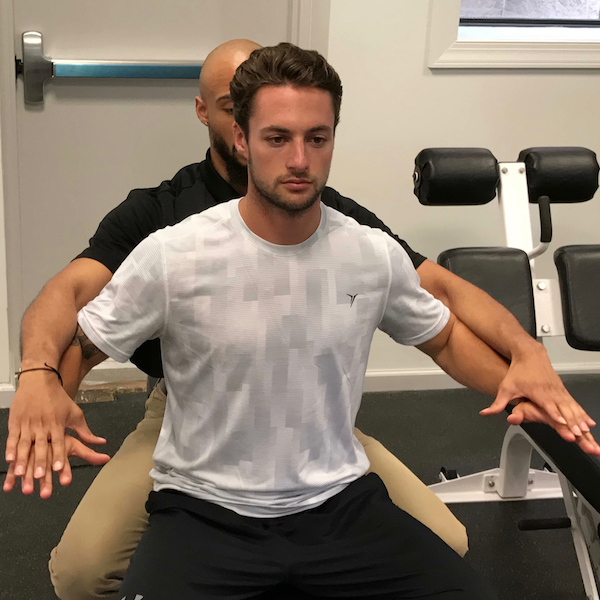Manual Resistance Training vs. Conventional Strength Training
You may have heard the term “manual resistance training” (or MRT) on the web or around the gym. Manual resistance training is a form of exercise that doesn’t incorporate any equipment at all. Instead you use your own body and gravity, or the body of a partner or “spotter”, to provide resistance.
Manual resistance training is popular among student and college athletes. This could be partly due to the fact that few gym facilities are needed to perform a MRT routine. This resource for student athletes lauds manual resistance training as “a creative, time efficient, and productive alternative to conventional strength training”. Their website provides an example of an MRT exercise:
“When working the shoulders and performing manual resistance lateral raises, the spotter stands behind the lifter with his or her hands on the lifter’s forearms. As the lifter raises his arms, the spotter provides an appropriate amount of resistance to overload the lifter’s shoulders, while still allowing the lifter to maintain a smooth, slow range of motion. Once the lifter has raised his arms to the appropriate position, the spotter begins to apply additional pressure while the lifter resists the downward pressure. As the lifter fatigues, the spotter applies less pressure until muscular fatigue occurs.”
Manual Resistance Training Techniques
MRT can be used to work any part of the body. The only difference is that you substitute out the equipment or free weights for a partner or personal trainer to provide the resistance. The spotter’s job is to match the appropriate amount of resistance to the level of fatigue and type of activity. A spotter also regulates the speed of the lift or contraction to ensure smooth movements and full range of motion. I was first exposed to the concept of MRT by Matt Brzycki in his presentation at the Strength and Conditioning Seminar and Convention at Rutgers University. Matt Brzycki (author of A Practical Approach to Strength Training) described a full range of exercises that you can do with a partner.
For example, you can perform a hip abduction exercise by lying on your side with legs straight and toes pointed toward the knee. With the spotter kneeling behind and applying resistance to your right ankle, you raise your right leg up as high as possible as the spotter provides resistance evenly throughout the full range of movement. A hip adduction can likewise be performed by sitting on the floor with legs bent and sides of the feet together. While kneeling in front, the spotter provides resistance to the insides of your knees as you attempt to touch them together.
The Benefits of MRT
The reason that MRT can be so effective is that a human can do something that a machine can’t. As you fatigue, a spotter can apply less and less resistance to match your maximum possible effort. This way, you achieve more muscle fatigue and a more effective workout. The spotter also ensures that you work to your full range of motion. It’s important to work a muscle throughout its full range of motion. You want to increase strength throughout the full range of the muscle. Working out through a full range of motion against resistance also prevents loss of flexibility.
To Use or Not Use Equipment?
This exact exercise is one that we incorporate into our HIT strength training routine here at Vertex Fitness. It is an effective way to perform lateral raises using a smooth action that decreases the chance for injury. But as you’ll know if you’ve stepped inside our studio, we incorporate a full range of resistance training equipment. The equipment helps us to isolate individual muscles and work them to maximum effort as we move through the routine. This is how we provide an effective workout in a fraction of the time you might spend in a gym.
But is manual resistance training any better for you than using gym equipment to provide resistance? To get the answer, we looked at a study titled “Manual Resistance versus Conventional Resistance Training: Impact on Strength and Muscular Endurance in Recreationally Trained Men”, published in 2017 in the Journal of Sports Science Medicine.
What the Science Says on Manual Resistance Training
This study focused on twenty males who already had some training background. They were divided into a manual resistance training and a conventional training group. The conventional group used a bench press and lateral pull-down machine to provide resistance. The MRT group provided similar movements, but using resistance provided by a personal trainer. The aim of the study was to compare the effects of an 8-week program on maximum strength and muscular endurance.
The Results
Although there wasn’t a big difference in any of the trainers from before and after their programs due to the short time frame, they did find a trend of improvement in strength and endurance changes. The study found that these improvements were slightly higher for the manual resistance training group. Because the advantages were so miniscule, they concluded that the effectiveness of manual resistance training is comparable to other routines. They concluded that MRT can be useful as a supplemental or alternative strength training program. It can also be used by personal trainers in low equipped facilities. The study is available for download here for those wishing to learn more.
Read more about the other Advanced Training Techniques:
Request a complimentary first session at Vertex Fitness, Voted the BEST Personal Training Studio on the Main Line
Click HERE and we will schedule a session to try it yourself



Leave a Comment